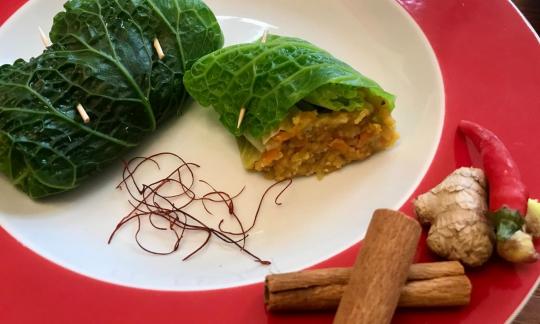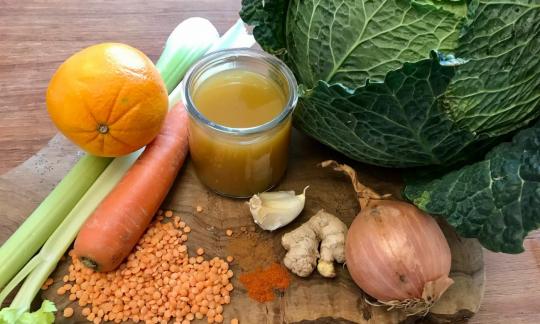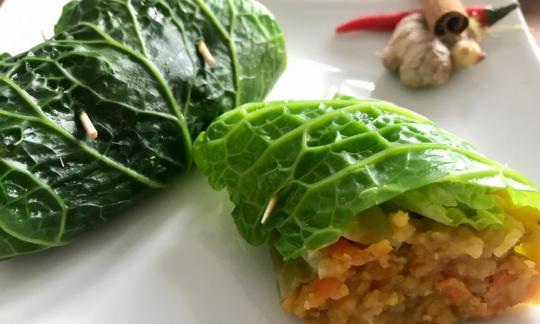Savoy cabbage rolls with red lentils, carrots and ginger
vegan
Ingredients (for servings, )
| For the savoy cabbage leaves | |
|---|---|
| 1 | Savoy cabbage, raw (Savoy cabbage, organic?) (18 oz) |
| For the filling | |
| 8 ½ oz | Lentils, red, raw (Erve, kitchen lentils) |
| 240 ml | Vegan vegetable stock, organic? (8.4 oz) |
| 16 oz | Drinking water, raw (organic?) |
| 1 | Onions, raw (organic?) (3.9 oz) |
| 2 cloves | Garlic (organic?) (0.21 oz) |
| 5 ½ oz | Carrots (carrots), raw (organic?) |
| 2 stalks | Celery (bleached celery), raw (organic?) (2.1 oz) |
| For seasoning | |
| 1 TL, gerieben | Ginger, raw (organic?) (0.10 oz) |
| ½ tsp | Cinnamon (ground, raw, organic?) (0.05 oz) |
| 1 tsp | Chili powder (raw?, organic?) (0.09 oz) |
| 1 dash | Table salt (table salt, raw?, organic?) (0.01 oz) |
| ½ | Oranges, raw (organic?) (2.3 oz) |
Equipment
- steamer basket
- grater
- vegetable peeler
- skillet (frying pan)
- stove
- citrus juicer (lemon squeezer)
- saucepan
- Rouladenklammer (Rouladenspange)
- sieve
Type of preparation
- cook
- chop or grind
- steam
- blanch
- squeeze
- sweat
- season to taste
- remove the skin
- peel
- rinse with cold water
- grate (shred)
- drain
Preparation
Prepare savoy cabbage leaves
Bring a large pot of lightly salted (optional) water to the boil. Remove any damaged savoy cabbage leaves and carefully separate whole savoy cabbage leaves from the cabbage and cut out a little of the middle stalk. Cut the remaining middle stalk flat from the underside of the leaf with a knife.We calculate 2 cabbage rolls per portion, for which you will need 4 large outer leaves.
Using the leftover savoy cabbage: Only the large outer leaves are suitable for wrapping the roulades. You can use the remaining savoy cabbage for another dish, such as baked savoy cabbage with spelt grains.
For 8 cabbage rolls (4 portions) we need 16 leaves. Wash the leaves and blanch them for 2 minutes. Then immediately rinse them with cold water and pat them dry so that they retain their green color.
For the filling
Put the vegetable stock and tap water in a pan with the lentils and bring to the boil. Simmer over a low heat with the pan covered for about 10 minutes. The lentils should be soft but not overcooked. Add a little more water if necessary. Ideally, the liquid should be completely evaporated by the end. If necessary, put the lentils in a sieve and allow to drain.During cooking, skip to step 4 to save some time.
You can find instructions for making your own vegetable stock here: Vegan vegetable stock.
Peel the onion and garlic and chop finely. Peel the carrots and dice finely (alternatively chop in a food processor). Clean the celery and remove the strings. Dice finely or chop in a food processor. Peel the ginger and grate finely.
Sauté the onions and garlic with 1-2 tablespoons of water in a non-stick pan. Add the ginger, carrot and celery and continue to sauté, stirring, until the fine vegetables are cooked. Always add a little water so that the vegetables do not stick. For the last 2 minutes, add the chili and cinnamon and sauté. The mixture should ultimately remain as dry as possible.
Completing the filling
Mix the cooked vegetables with the lentils and season with chili, salt and the juice of 1/4-1/2 orange per 4 portions. Make sure that the consistency of the mixture is not too runny.Finishing and serving the roulades
Place 2 savoy cabbage leaves on top of each other and add 1/8 of the filling (for 4 portions). Fold in the sides of the leaves and then carefully roll up from the end. Hold together with roulade clips or 2 toothpicks. Do the same with the rest.Just before serving, place the finished roulades in a steamer and steam for a few minutes. Since the roulades contain both vegetables and lentils, you don't need any other side dishes.
Serve warm and enjoy!
Prepare in advance: Since the roulades are steamed at the end, they can be prepared a few hours before the meal.
|
Nutritional Information per person
Convert per 100g
|
2000 kcal | |
|---|---|---|
| Energy | 300 kcal | 15.0% |
| Fat/Lipids | 2.0 g | 2.9% |
| Saturated Fats | 0.33 g | 1.7% |
| Carbohydrates (inc.dietary fiber) | 57 g | 21.0% |
| Sugars | 8.1 g | 9.1% |
| Fiber | 13 g | 53.4% |
| Protein/Albumin | 18 g | 36.4% |
| Cooking Salt (Na:152.9 mg) | 388 mg | 16.2% |
| Essential micronutrients with the highest proportions | per person | 2000 kcal | |
|---|---|---|---|
| Vit | Vitamin K | 105 µg | 140.0% |
| Vit | Folate, as the active form of folic acid (née vitamin B9 and | 251 µg | 126.0% |
| Min | Copper, Cu | 0.94 mg | 94.0% |
| Prot | Threonine (Thr, T) | 0.72 g | 78.0% |
| Min | Manganese, Mn | 1.5 mg | 75.0% |
| Vit | Vitamin C (ascorbic acid) | 56 mg | 70.0% |
| Prot | Tryptophan (Trp, W) | 0.17 g | 70.0% |
| Prot | Isoleucine (Ile, I) | 0.83 g | 67.0% |
| Prot | Lysine (Lys, K) | 1.2 g | 67.0% |
| Prot | Phenylalanine (Phe, F) | 0.87 g | 56.0% |
Detailed Nutritional Information per Person for this Recipe
The majority of the nutritional information comes from the USDA (US Department of Agriculture). This means that the information for natural products is often incomplete or only given within broader categories, whereas in most cases products made from these have more complete information displayed.
If we take flaxseed, for example, the important essential amino acid ALA (omega-3) is only included in an overarching category whereas for flaxseed oil ALA is listed specifically. In time, we will be able to change this, but it will require a lot of work. An “i” appears behind ingredients that have been adjusted and an explanation appears when you hover over this symbol.
For Erb Muesli, the original calculations resulted in 48 % of the daily requirement of ALA — but with the correction, we see that the muesli actually covers >100 % of the necessary recommendation for the omega-3 fatty acid ALA. Our goal is to eventually be able to compare the nutritional value of our recipes with those that are used in conventional western lifestyles.
| Essential fatty acids | per person | 2000 kcal |
|---|---|---|
| Alpha-Linolenic acid; ALA; 18:3 omega-3 | 0.22 g | 11.0% |
| Linoleic acid; LA; 18:2 omega-6 | 0.75 g | 7.0% |
| Essential amino acids | per person | 2000 kcal |
|---|---|---|
| Threonine (Thr, T) | 0.72 g | 78.0% |
| Tryptophan (Trp, W) | 0.17 g | 70.0% |
| Isoleucine (Ile, I) | 0.83 g | 67.0% |
| Lysine (Lys, K) | 1.2 g | 67.0% |
| Phenylalanine (Phe, F) | 0.87 g | 56.0% |
| Valine (Val, V) | 0.91 g | 56.0% |
| Leucine (Leu, L) | 1.3 g | 53.0% |
| Methionine (Met, M) | 0.17 g | 18.0% |
| Vitamins | per person | 2000 kcal |
|---|---|---|
| Vitamin K | 105 µg | 140.0% |
| Folate, as the active form of folic acid (née vitamin B9 and | 251 µg | 126.0% |
| Vitamin C (ascorbic acid) | 56 mg | 70.0% |
| Vitamin A, as RAE | 428 µg | 53.0% |
| Vitamin B6 (pyridoxine) | 0.64 mg | 46.0% |
| Thiamine (vitamin B1) | 0.46 mg | 42.0% |
| Riboflavin (vitamin B2) | 0.16 mg | 12.0% |
| Niacin (née vitamin B3) | 2.0 mg | 12.0% |
| Pantothenic acid (vitamin B5) | 0.72 mg | 12.0% |
| Vitamin E, as a-TEs | 0.94 mg | 8.0% |
| Biotin (ex vitamin B7, H) | 3.6 µg | 7.0% |
| Essential macroelements (macronutrients) | per person | 2000 kcal |
|---|---|---|
| Potassium, K | 990 mg | 50.0% |
| Phosphorus, P | 269 mg | 38.0% |
| Magnesium, Mg | 88 mg | 23.0% |
| Sodium, Na | 153 mg | 19.0% |
| Calcium, Ca | 125 mg | 16.0% |
| Essential trace elements (micronutrients) | per person | 2000 kcal |
|---|---|---|
| Copper, Cu | 0.94 mg | 94.0% |
| Manganese, Mn | 1.5 mg | 75.0% |
| Iron, Fe | 5.5 mg | 39.0% |
| Zinc, Zn | 2.8 mg | 28.0% |
| Fluorine, F | 113 µg | 3.0% |
| Selenium, Se | 1.9 µg | 3.0% |
| Iod, I (Jod, J) | 2.0 µg | 1.0% |
The savoy cabbage rolls with red lentils, carrots and ginger can be prepared well in advance.
Portion size: The quantity is sufficient for 4 people or 2 roulades per portion - you need 2 large outer leaves per roulade.
Nutrient profile: According to GDA guidelines, one portion covers 100% of the average daily requirement of folic acid. Vitamin K and copper are covered by more than ¾. The dish also contains more than 50% of the daily requirement of many essential amino acids. The ratio of omega-6 to omega-3 fatty acids is 4:1, which is below the maximum recommended ratio of 5:1. You can find more information at: Vegans often eat unhealthily. Avoidable nutritional errors.
Savoy cabbage: Savoy cabbage is in season almost all year round. When buying it, make sure that the curly leaves are deep green and have no yellowish spots. Savoy cabbage is rich in vitamins and minerals, especially when eaten raw.
Red lentils: Due to their high-quality proteins, lentils are a very good source of plant-based protein for vegans. The different types of lentils, which are uniformly round and flat in shape, differ not only in size but also in color. Red lentils come from India and are particularly well-known from the national dish Dal. Because they are peeled, they cook quickly and break down into a kind of mush. Soaking beforehand is therefore not necessary. Because they are not peeled, they absorb the flavor of spices particularly well.
Carrots: Carrots are particularly rich in carotene, a precursor to vitamin A, which gives them their typical orange color. Vitamin A is important for our eyesight, among other things, but also for the immune system.
Celery: Celery, also known as celery sticks, is a variety of real celery. It has a mild taste of celery, but its high water content gives it a fresh, juicy and crunchy consistency. Thanks to its water content, it is one of the lowest-calorie vegetables. Its typical smell is due to the high content of essential oils, which are found in all of its plant organs in so-called oil ducts. Celery also contains antioxidant vitamins such as vitamin C or beta-carotene and many polyphenols (secondary plant substances), which slow down or completely prevent oxidation processes.
Ginger: Ginger has an aromatic smell and a sharp, spicy taste, which is due to the (spicy) substance gingerol, which is said to have anti-carcinogenic and anti-inflammatory effects. The substances borneol and cineol give ginger its digestive, antiemetic, appetite-stimulating and circulation-stimulating properties. The ginger rhizome is used in cooking in fresh, dried or ground form.
Using the leftover savoy cabbage: You can use the remaining savoy cabbage for another dish, such as baked savoy cabbage with spelt grains.
Prepare in advance: Since the roulades are steamed at the end, they can be prepared a few hours before the meal.
Reduce salt and oil: We have consciously reduced salt and left out oil for health reasons. You can find more information on this topic in our book, which we describe in detail: "Salt Sugar Fat" by Michael Moss.
Steaming versus cooking/baking: The advantage of steaming compared to cooking is that hardly any ingredients are lost and the flavor remains more intense. That's why we just steam the roulades at the end instead of baking or frying them again in the oven or pan.
Roulade: The word "roulade" originally comes from the French-speaking area and is derived from "rouler" (i.e. "to roll"). In gastronomy, this is used to describe filled rolls that are made up of slices of meat, fish or, as in this recipe, cabbage leaves, and that are braised in a stock or a suitable sauce. The names for roulades vary depending on the region. For example, the term "Fleischvogel" is common in the south of the German-speaking area when it comes to meat roulades, and those made from cabbage leaves are called "Wickel".
Prepare your own vegetable stock: You can find vegetable stock as a ready-made product in many large supermarkets. Nevertheless, making your own vegetable stock is relatively straightforward. The ingredients can be adapted to suit your taste and allow you to optimally cover individual taste requirements. We also recommend making your own, especially with regard to artificial additives or preservatives in low-quality ready-made products. You can find the instructions for a stock we have put together under the following link: Vegan vegetable stock.








